
 |
||||||||
 |
||||||||
Artifacts




- ICS info. booklet
- 1918 M.V. Registration
- Troyler Patent
- Scranton School District Manual
- Maloney Memorial Home for Aged
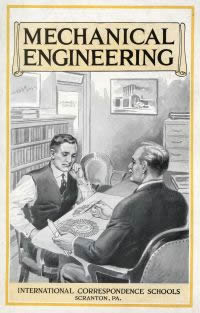 |
The International Correspondence Schools was a Scranton fixture from 1897 through 1996. Its successor organization, Penn Foster Career School, still has a vibrant Scranton presence. Established to help working men and women receive the technical education they needed to enter skilled jobs, ICS celebrated its six millionth student in 1952. Among the number of informational and instructional booklets in our collection, we have chosen to display an informational booklet from the 1940s. In addition to testimonials from former students, it provides details on a number of different courses of study and the instructional booklets needed for each. When a student enrolled at ICS, he or she was sent instructional books as needed. The student studied the material and mailed in homework or other assignments which were graded and returned. If a student had trouble with a lesson, ICS provided a person to help resolve the problem. |
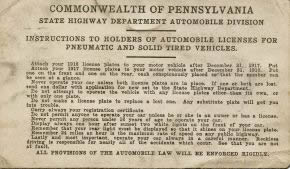 |
A recently uncovered archive of one of Scranton’s insurance agents contains mostly bills and receipts from the period 1880-1920. It is a fabulous window on everyday life for a time frame that no one remembers now. There are bills for buying and repairing a buggy as well as a purchase agreement for a Model-T touring car. The 1918 Automobile Certificate (car registration) displayed includes a number of important rules of the day such as: Display always one hour after sunset two white lights on the front of your car; 24 miles per hour is the maximum rate of speed on any public highway; and Do not make a license plate to replace a lost one. Any substitute plate will get you into trouble. There also is a handwritten itemized receipt for $8.25 for oats, hay, rye, and feed. It’s amazing what some people will save, but their records enable us to remember or learn about days gone by. |
 |
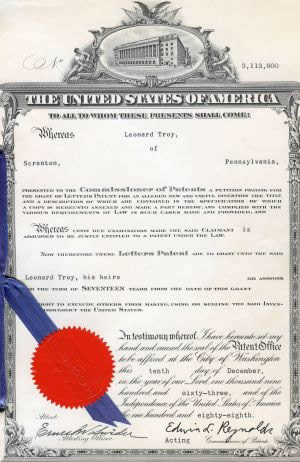 |
Patent No. 3,113,800 was issued December 10, 1963 to Leonard Troy of Scranton for an improved version of the Automobile Transport. The justification for this patent is that “As a general rule, in the transportation business, the greater the cargo, the less the unit hauling rate. At the present time, due to length and axel loading restrictions in many of the states, particularly the eastern states, automobile transports are limited to hauling four full size American automobiles. It is readily apparent that if an automobile transport could be provided for hauling five full sized American automobiles, including the larger ones manufactured, there would be a definite decrease in hauling costs per automobile. It is to this end that the present invention relates.” Troy, an engineering graduate, was involved in designing gliders for the military during World War II before he joined the army himself. After the war, he and his father founded Metropolitan Convoy, an automobile transport company located in Clarks Summit. This lead to Troy’s interest in improving the trailers of the day. He had invented the basic “Troyler” in 1953 by redesigning trailers to be lighter so that they would use less gasoline, be easier to handle, and cause less wear on their parts. These were built at the Troyler Corporation factory at Glenn Street and Meylert Avenue in Scranton. Mr. Troy applied advanced engineering innovations to a variety of concerns thereby producing a large number of patents including zone-controlled heating systems for buildings. |
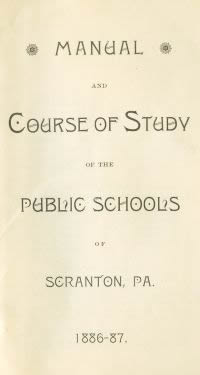 |
The Scranton School District in 1886 consisted of 33 schools, numbered but not yet named. At left is the title page of a 62-page booklet that provides a snapshot of the district at the time. The manual reads, “No pupil shall be admitted to school who is not six years of age, or who has not been vaccinated.” According to the manual, the school system was arranged as follows: The Common School Department consisted of nine levels: Grammar A, B, and C; Intermediate A, B, and C; and Primary A, B, and C, with appropriate studies and regulations for each. The High School Department included three levels: Preparatory, First Year, and Second Year. While the manual describes the Common School structure in detail, the High School section lists only courses and required texts. Among the courses studied at the High School levels were: astronomy, geometry, physics, trigonometry, literature, Latin, botany, and moral philosophy. Composition, declamation, mental science, political economy, and Greek also were part of the curriculum. According to the manual, “None but High School graduates of normal course or of State Normal Schools” were to be employed as teachers. There were more than 10,000 students in the district that year, of which 230 were in the High School Department. |
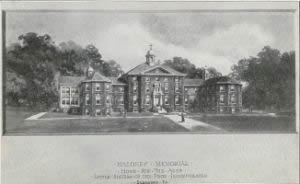
The Maloney Memorial Home for the Aged was endowed by Martin Maloney in memory of his parents and was run by the Little Sisters of the Poor. On May 26, 1907 a cornerstone from Martin Maloney’s home in Ireland was blessed and laid for the Home while a cornerstone from Holy Cross Abbey in Ireland was laid for the chapel. At the time of its 30th anniversary, the Home had 150 residents of 60 years or older. In 1972, it no longer met codes and had to be replaced. The Holy Family Residence of the Little Sisters of the Poor in Scranton is its direct descendent. Martin Maloney was born in Tipperary, Ireland on Nov. 11, 1847 and came to Scranton at the age of seven years. He had a small tin roofing and heating business when he visited the Philadelphia Centennial Exposition in 1876 and saw a gasoline lamp which he adapted for street lighting—an invention that made him a fortune. He married Margaret Hewitt from Carbondale at St. Peter’s Cathedral, Scranton, on Dec. 31, 1868. He also endowed the Martin Maloney Science (Chemistry) Building at The Catholic University of America, St. Catharine’s Church in Spring Lake, NJ, and was a donor to the Shrine of the Immaculate Conception. He was given a papal marquis by Pope Leo XIII (June 25, 1903) and was appointed a Camera Secreta by Pope Pius X (June 16, 1904).
Copyright 2011 © The Lackawanna Historical Society, Scranton PA